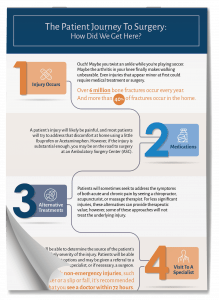SHOULDER ARTHROSCOPY
When you stop to think about it, the shoulder is an amazing joint, providing you with a huge range of motion. Until something goes wrong. When you begin to experience shoulder pain, your mobility can feel curtailed and your quality of life can suddenly plummet. Simple tasks, such as driving or showering, can become incredibly painful (if not impossible).
When non-surgical therapies do not yield positive progression, your orthopedic team may recommend surgery to treat your shoulder injury. Most commonly, this will mean a minimally invasive procedure called shoulder arthroscopy.
What is shoulder arthroscopy? Well, instead of making one single incision, shoulder arthroscopy uses a combination of miniaturized tools and tiny incisions to diagnose and repair shoulder injuries. As a result, shoulder arthroscopy typically produces less discomfort, faster healing, and happier patients than more invasive surgical options.

What Happens During Shoulder Arthroscopy?
Shoulder arthroscopy is typically performed on an outpatient basis. This means you’ll arrive for surgery, undergo your procedure, and return home all in the same day. And because no overnight stay in a hospital is required, many patients will request that their shoulder arthroscopy be performed in an ambulatory surgery center–a more clinic-like atmosphere that provides all the safety of a hospital without the associated noise, crowding, and expense.
In most cases, shoulder arthroscopy is performed using a nerve block or local anesthetic. If you feel a general anesthetic is necessary, talk to your orthopedic team about the best way to proceed.
Once surgery begins, your orthopedic surgeon will make a small, half-inch incision in your shoulder. A device called an arthroscope is then inserted into the incision. This device is essentially a tiny camera on the end of a long fiber-optic tube. And it allows your orthopedic team to see what’s happening within your shoulder. In this way, your physician will be able to better diagnose the cause of your shoulder injury or trauma.
Shoulder Arthroscopy Can Also Repair Damage
Depending on what your orthopedic team sees on the arthroscopy, they may be able to repair some damage to your shoulder. To do so, additional small incisions will be made in your arm (sometimes several of these small incisions are needed to accommodate additional tools).
Your surgeon will then be able to use special miniaturized surgical tools to help repair damage and trauma to your shoulder. Shoulder arthroscopy can be used to remove inflamed or damaged tissue, shave down areas of bone, suture tissue, and anchor stitches to the bone. The precise operation of these tools will vary depending on the type of reconstruction your orthopedic team needs to accomplish.
Rotator cuff repairs are among the most common such injuries. During rotator cuff repair, the torn tendon is reattached to the head of the humerus (your upper arm bone) using special sutures.
Some of the conditions that shoulder arthroscopy can repair include the following:
- Bone spurs
- Some injuries to the shoulder socket (such as a labrum tear)
- Rotator cuff injuries, such as tears and tendinitis
- A condition known as “frozen shoulder”
- Osteoarthritis
- Damage from a dislocated shoulder
This list is not exhaustive. You should talk to your orthopedic team about shoulder arthroscopy and whether you’d be a good fit for this procedure.
Shoulder Arthroscopy Recovery
How long is recovery after shoulder arthroscopy? That’s what many patients want to know before they commit to this procedure. And it’s a reasonable question–you use your arms a lot!
The major takeaway from shoulder arthroscopy is that pain and discomfort are significantly lower than they would be from a more invasive surgical approach. So, then, how long is recovery after shoulder arthroscopy recovery? The answer truly depends on the extent of work performed during your procedure.
In general, however, patients can expect the following:
- Your arm will likely be in a sling for several days to several weeks while your shoulder heals.
- After the first few days of recovery, you’ll be able to remove your large bandages and switch to more common band-aids.
- Your orthopedic team will provide you with pain management medication. Treating your pain is essential, as this allows you to heal faster (and more comfortably).
- In general, you should be able to return to work (assuming it’s not physically demanding work) within a week or two.
The return of full mobility after shoulder arthroscopy can take anywhere from several weeks to several months. It depends on how much work your surgeon performed and the nature of your original injury.
So how long does the pain last after shoulder arthroscopy? That will also depend. Usually, pain can be managed by over-the-counter medications after a couple of weeks or so. But if you have any concerns about post-surgical pain and discomfort, talk to your orthopedic surgeon about what you can expect.
A Less Invasive Solution
When compared to more intense surgical options, it’s important to note that recovery from shoulder arthroscopy is faster and easier. This means you’ll be able to return to your daily life faster and more comfortably.
That’s why shoulder arthroscopy is a popular solution for shoulder trauma and injury. This is especially true for patients who opt to undergo shoulder arthroscopy in an ambulatory surgery center setting. An ASC feels much more like a clinic than a hospital, so patients tend to be more comfortable and happier. To find out how you can have your shoulder arthroscopy performed at an ambulatory surgery center, talk to your orthopedic team today!
The Patient Journey to Surgery: How Did We Get Here?
Everyone’s journey will be different, but the basic steps will often be similar. Discover where you are in the process–and what comes next. Download our resource and find out how where you are on your journey to surgery.







